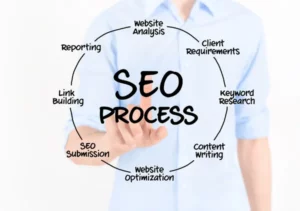Introduction to SEO-Friendly Blogging
In the digital age, where content is king, understanding and implementing SEO (Search Engine Optimization) in your blogging strategy is essential. This introduction will cut straight to the chase, highlighting the undeniable importance of SEO in blogging.
We’ll explain how mastering SEO-friendly techniques is a game-changer, significantly boosting your blog’s visibility and driving more traffic to your site. By optimizing your content for search engines, you’re not just throwing words into the digital abyss; you’re strategically placing them where they’ll be seen, read, and appreciated.
Let’s dive into how you can transform your blog into an SEO powerhouse.
The Ultimate Aim of Blogging for SEO
Everyone talks about the importance of having an active blog, but let’s take a moment to talk about what we’re trying to achieve with blogging.
Blogging for SEO goes beyond mere content creation; it’s a strategic move that brings substantial benefits to your website. High rankings in search results directly translate to increased visibility and quality traffic, which can lead to tangible business growth. Additionally, a regularly updated blog with SEO-focused content keeps your website active in the eyes of search engines like Google, enhancing your site’s overall ranking potential.
A well-executed blog also serves as a valuable resource, attracting backlinks from other websites. When your content is informative and insightful, it naturally encourages others to link to your site, increasing your domain authority and improving your search engine rankings.
Beyond technical SEO advantages, a top-ranking blog establishes your authority in your field. It builds trust and credibility with your audience, positioning you not just as a participant in your industry, but as a leading voice and a trusted expert. Your blog is more than a tool for SEO; it’s a platform to demonstrate your expertise and influence in your niche.
Topic Selection for SEO Blogs
It should come as no surprise that choosing the right topic is first and foremost about finding something unique and interesting to talk about. If you offer a new perspective and idea, or contribute something original to the internet, Google has good reason to ensure your posts are ranked for relevant search terms.
That said, in today’s content-heavy world, sometimes providing quality isn’t enough. There is so much being posted and uploaded every minute and even good quality content can be buried in the sheer volume of information out there.
There are other things you should be mindful of to help get your content seen and give it the best chance of generating traffic to your blog and website:
- Try to target topics with high search volume and low competition is also a recipe for success. You can use various tools like Ahrefs to help you identify opportunities.
- Don’t get too bogged down in writing precisely on the products or services you provide. This can limit the scope of your content too much and can indicate that you’re only writing to turn readers in customers. Writing and posting content that isn’t directly related to a product or service can be a good strategy to cast a wider net.
- Recognize that sometimes non-relevant traffic is helpful too. If you write a blog post on something tangentially related to your service that ranks, it’s a win even if these users are only after information rather than being potential customers.
Optimizing for SEO

So, you’ve got your topic locked down and you’ve identified the general cluster of keywords you want to go after – fantastic start. To give your blog the best shot at ranking for those keywords, there are a few things you should be mindful of in the writing of the post.
The Technical Stuff
Incorporating target keywords into your title tags, meta descriptions, and headers not only helps search engines understand your content but also improves click-through rates from search results. If you’ve identified long-tail keywords that might be easier to rank for, make mention of them and you could even create headings out of this information if you do so in a natural way.
Internal linking is also crucial. By linking to other relevant posts on your site, you help Google understand the page hierarchy of your website and get its head around what each page is about. It’s really important to not simply do this to tick it off your list, but to actually think about what terms and phrases you’re linking to a given page – it needs to be highly relevant and the target page should provide further reading or clarification on this topic or idea. Make sure you link to other blog posts as well!
Categorizing your blog posts according to topic also makes it easier for Google to understand them and what they are about. This is often overlooked but should definitely be on your list, particularly for blogs that have a large number of posts.
Readability
While the technical elements ensure Google can get a sense of your post and rank it for the right keywords, readability considerations ensure that users are going to have the best chance of engaging with the post. Given that search engines monitor aspects like bounce rates, time on page and click-through-rates, there is some crossover. If your post is readable, chances are it ticks off some of the things Google is looking for anyway. Consider the following tips:
- Hook your readers from the get-go with an intriguing opening. Whether it’s a surprising fact, a question, or a bold statement, make sure it grabs attention.
- Use supporting references to add credibility. You can link to other blog posts that reference some of the information that you are publishing for example.
- No one reads entire posts from start to finish nowadays. Break your content into digestible sections with clear subheadings. This makes your post more scannable for quick readers.
- Keep your paragraphs short and sweet. Large blocks of text can be daunting. Aim for 2-3 sentences per paragraph to keep things light and easy to read.
- Whenever possible, use bullet points or numbered lists. They’re a great way to present information clearly and concisely, making it easier for readers to digest and remember.
Making your Post Linkable
Any time you have someone link to your blog post, count it as a massive win and give yourself a pat on the back. This may be unlikely prior to earning some traffic and SEO-kudos on the post, but it does happen from time to time. Here are a few ways to give your post every chance of being linked to:
Use Original Research and Data: Posts that include original research, surveys, or unique data are gold mines for backlinks because they provide new information that others may want to reference in their own content.
Craft Comprehensive Guides and Resources: Comprehensive guides, how-to articles, and resources that cover a topic thoroughly are incredibly link-worthy because they serve as a one-stop-shop for information on a particular subject.
Design Infographics and Visual Content: Visual content like infographics, charts, and graphs are highly shareable and linkable because they present information in an easily digestible and visually appealing format.
Support the Post with Video Content: Video content is often considered the preferred way for users to get information in 2024. Use this to your advantage and create a video to support what you are saying in the post. Google also wants to rank pages with video content so this will work to your advantage in more ways than one!
Conclusion
Mastering SEO-friendly blogging is an essential skill in today’s digital landscape, where the competition for visibility is fierce but the rewards for success are substantial.
From understanding the foundational importance of SEO in driving traffic and enhancing visibility to implementing advanced strategies for optimizing content and encouraging backlinks, this comprehensive guide has covered the critical aspects of creating a blog that not only ranks well in search engines but also engages and retains readers. Remember, the journey to SEO mastery is ongoing, requiring constant learning, adaptation, and experimentation.
By focusing on creating high-quality, valuable content, optimizing every aspect of your posts for search engines, and actively promoting your blog across various platforms, you can build a strong, authoritative online presence that drives success.
Whether you’re a seasoned blogger looking to refine your strategy or a newcomer eager to make your mark, the principles of SEO-friendly blogging are your roadmap to achieving your digital goals. Embrace the challenge, stay committed to excellence, and watch as your blog grows from a hidden gem to a leading voice in your niche.

